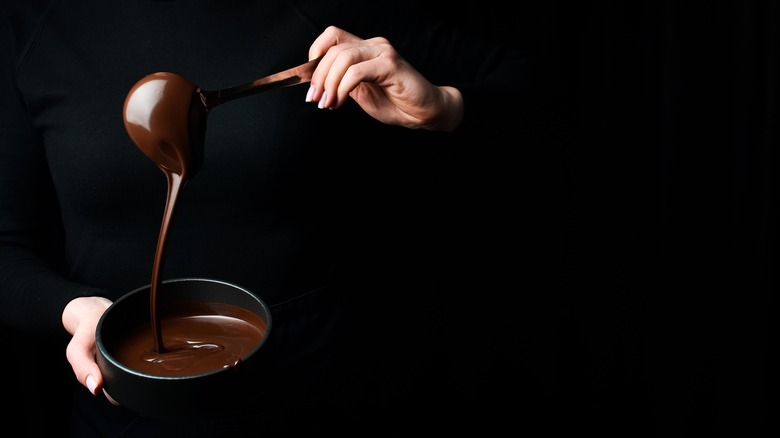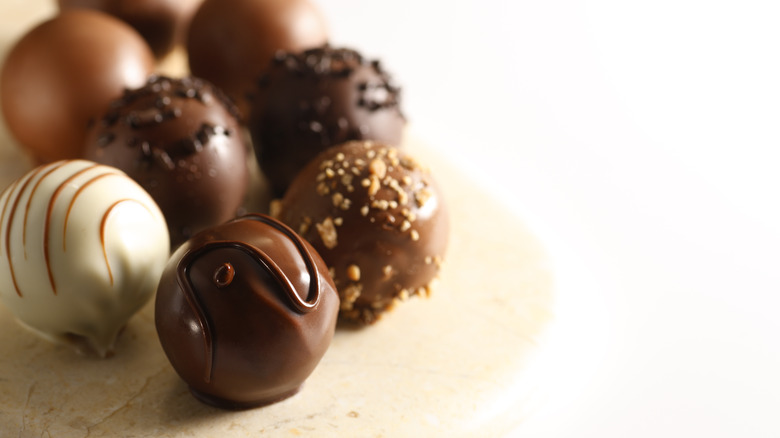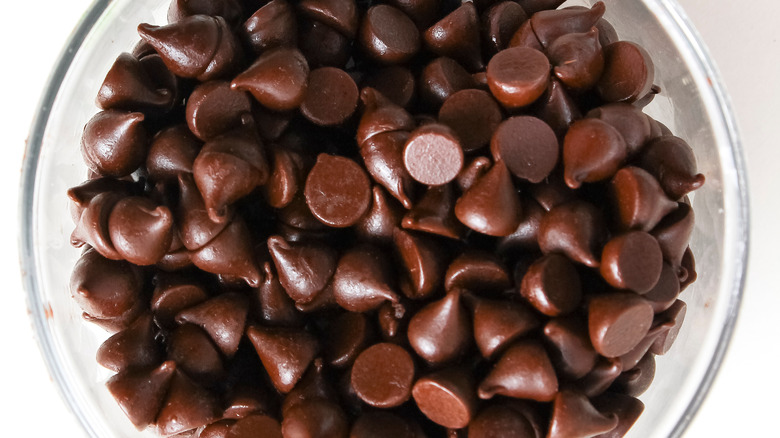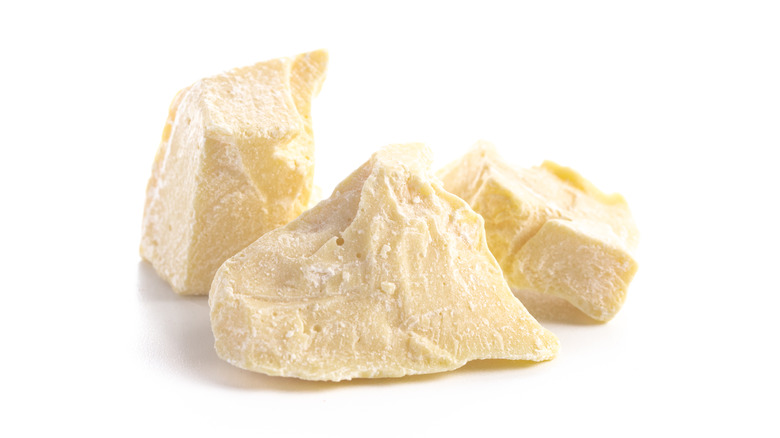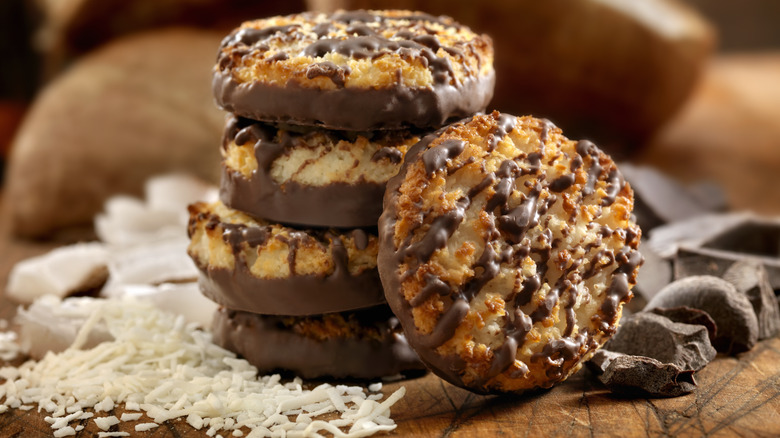Couverture Vs Compound Chocolate: The Difference You Can Taste
It's not breaking news that chocolate has a wide swath of variation, and not just the obvious classifications of milk, dark, and white chocolates. Everyone has had the experience of biting into an inferior chocolate that feels like an insipid insult to good taste and the divine experience of letting quality chocolate enrobe the mouth. As you might imagine, the chocolate world is a complex one full of industry jargon and technical terms that seem opaque to outsiders. Take, for instance, couverture and compound chocolate — these terms are at once elegant and inscrutable. Yet, they are important distinctions when it comes to the production and overall quality of chocolate end-products.
While we know that all chocolate starts out with the cocoa bean pod, this is also where the wide world of chocolate starts to diverge. From this plant, the cacao tree (Theobroma cacao), several elements are derived. These include chocolate liquor, cocoa butter, nibs, and cocoa solids. It is how these products are combined, in what proportions, and with what external ingredients that determines the type of cocoa product that is made. Couverture and compound chocolate represent two types of chocolates frequently used in confections, but their important distinctions lead to quite different outcomes in terms of quality, mouthfeel, and flavor.
What is couverture?
There's no denying that couverture, with its round French pronunciation, is the more luscious of the two terms. There's even something to be said for how the name mirrors the nature of the substance. Couverture is a type of chocolate in the same way that a BMW M TwinPower Turbo V8 is a type of automotive engine. It is an ingredient that makes the finished product exceed expectations via its masterful composition.
The flavor of a chocolate comes from the cocoa solids that are processed from the cocoa bean after it has been fermented and roasted. For couverture, which is from the French "to cover," chocolate liquor — a combination of cocoa solids and cocoa butter — is ground into a fine paste. This is critical to how the chocolate performs as it is being worked with as well as how it plays across the palate. Further, couverture contains a healthy amount of cocoa butter — a minimum of 31% by U.S. requirements — meaning that it is more wholly constituted from cocoa-derived components than other chocolates. Premium couverture will contain no fats other than cocoa butter. Other ingredients include sugar, the emulsifier lecithin, and milk powder if making milk chocolate.
What is compound chocolate?
The term compound chocolate sounds a bit cold and clunky by comparison, akin to utility-grade beef. But, it's a name that does a disservice to the substance, as compound chocolate is perfectly good. In fact, if you're munching on mass-produced chocolate in the US, you're likely chowing on some compound chocolate.
The composition of compound chocolate is not all that different from couverture in terms of fats and solids. The latter is still cocoa-derived but is generally not ground quite as fine as the cocoa solids in couverture and comes from cocoa powder, which consists of the solids that are left after the cocoa butter is removed. As such, the fat is where the two chocolates really differ. While couverture uses a significant portion of cocoa butter as the fat, compound chocolate generally does not. The fat in it is vegetable in origin, like coconut or palm kernel oil. These are cheaper than cocoa butter and can be easier to work with. These properties are what make compound chocolate the go-to for large-scale chocolate production.
Couverture's cocoa butter advantage
As you may have surmised, the key difference between couverture and compound chocolate is the cocoa butter content. Not only does this make couverture more wholly derived from the cocoa bean pod, but the cocoa butter also imparts properties all its own that make it desirable to gourmet chocolatiers. Cocoa butter is a wonderfully glossy fat that gives couverture a signature sheen and makes for a wonderful coating chocolate, hence the name.
Couverture is often used for making delicate shells on bonbons and for dipping truffles. But, that cocoa butter comes with some work, as it is finicky. Couverture must be properly tempered — a process of precise heating and cooling — before it can be worked with. This allows the crystals in the cocoa butter to align in the correct manner. Not only does this improve the appearance of the couverture, but it gives it a pronounced snap when broken or bitten and allows the chocolate to melt evenly across the mouth when savored.
Don't count compound chocolate out
So, couverture is better chocolate, right? Well, it is certainly more expensive given the stringency of the ingredients and the processing needed to make it. And, it indeed often comes into play when dealing with high-end chocolate confections. All of that doesn't add up to primacy, though. Compound chocolate, while cheaper and adulterated with non-cocoa fats, has its place in the world of sweets, even edging out couverture in some avenues.
Take baking and decorating, where the cocoa butter-heavy couverture just doesn't cut it. Compound chocolate's vegetable oil components make it easy to melt and use for decorating cakes, filling cookies, and lining molds for elaborate designs. While couverture may reign supreme in the realm of cocoa coatings, compound chocolate can also be used for truffles, cookies, and candy bars, though it will lack the sheen of its haughty cousin. Compound chocolate is also a great place for beginners in the chocolate world. While it might not have the refined aesthetic and toothsome appeal of couverture, compound chocolate is much more forgiving, easy to store, and affordable.
